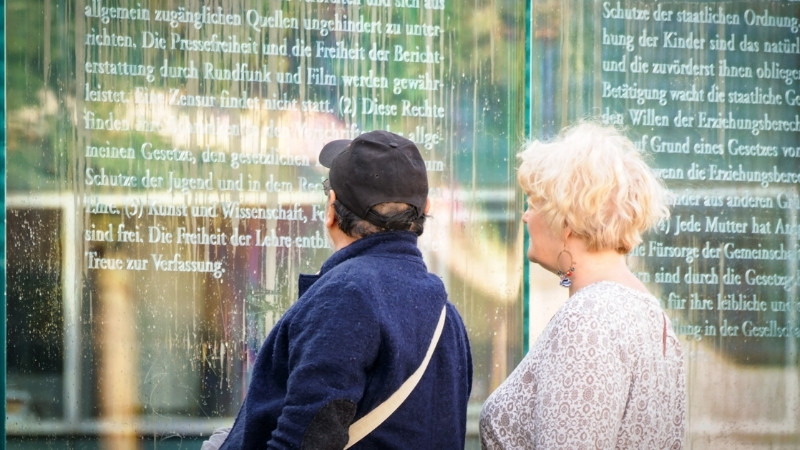Germany Time Travel I and II
Die Arbeiten Germany Time Travel I and II versetzen den Betrachter in eine Zeit zurück, in der die Berliner Mauer im Zentrum des internationalen politischen Interesses stand. Die Fotografien spielen mit der Wechselwirkung zwischen der visuellen Wahrnehmung lokaler Details und globalem Umfeld. Auf den ersten Blick fallen Elemente wie scheinbar abstrakt anmutende Muster und Anklänge an geometrische Formen ins Auge. Erst bei genauerer Betrachtung – und unter Zuhilfenahme der vom Künstler gewählten Titel der Arbeiten – erkennt man Teile der Berliner Mauer und damit den größeren Kontext der Bilder.
Die Fotografien halten das Vergängliche und die jüngere Vergangenheit fest. Die zentral positionierten rostigen Nägel mahnen zur Erinnerung an die Geschehnisse an der Mauer und an ihre Geschichte. Andererseits werfen sie aber auch einen Blick auf die Zukunft: das Grün der Rahmen-Linien auf der Mauer und der Grasflächen steht für Wachstum, für die Kraft der Natur und für die Entstehung von etwas Neuem. Auch die Öffnung in der Mauer ist eine optimistische Nuance – zwar ist sie noch in der Ferne sichtbar, aber ein Wandel erscheint möglich.
Mehr als 30 Jahre nach dem Mauerfall rufen die Fotografien bei zahlreichen Betrachtern zweifellos eigene Erinnerungen an die deutsche Teilung und die Berliner Mauer als Symbol dieser Zeit hervor. Individuelle Assoziationen bahnen sich einen Weg in das visuelle Erleben der Bilder. Ihre Wirkung gründet in der historischen Realität, aber auch in den sehr persönlichen Geschichten, die sie auslösen. Damit geht sie weit über Vordergründiges hinaus.
Die Fotografien Germany Time Travel I and II von Heinz Peter Schepp sind mehr als ein Verweis auf die Vergangenheit. Sie stehen für eine Auseinandersetzung mit der Gegenwart, für einen Aufruf zur Reflektion über Mauern im Denken und Handeln, die eine nachhaltige Wirkung entfalten und Entscheidungen mitbestimmen können, aber erst mit gebührendem räumlichem und zeitlichen Abstand als solche zu erkennen sind.
Prof. Dr. Irene Daum
English:
Germany Time Travel I and II
The art works Germany Time Travel I and II take the viewer back to a period of time when the Berlin Wall was the focus of international political interest. The photographs play with an interaction between the visual perception of local details and more global scenes and contexts. At first glance, visual elements such as seemingly abstract patterns and patterns resembling geometric shapes catch the eye. Only on closer inspection – and with the help of the titles chosen by the photographer – do we recognize parts of the Berlin Wall and become aware of the larger context of the images.
The photographs capture the fleeting nature of life as well as the recent past. The centrally positioned rusty nails remind us of the events which took place at the Wall and its unforgettable history. On the other hand, however, they art works also look to the future: the green of the frame lines on the wall and of the grassy areas stand for growth, for the power of nature and for the emergence of something new. The opening in the wall is also an optimistic nuance – it is still visible in the distance, but change appears to be already on the horizon.
More than 30 years after the fall of the wall, the photographs undoubtedly evoke in many viewers their own memories of the division of Germany and of the Berlin Wall as a symbol of that time. Individual associations pave their way into the visual experience of the pictures. Their effect on the viewer is strongly related to historical reality, but it is also based on the very personal stories they trigger and thus goes far beyond the superficial.
The photographs Germany Time Travel I and II by Heinz Peter Schepp are more than a reference to the past. They stand for a confrontation with the present political and social situation, for a call to reflect on walls in people`s thoughts and convictions which can have a lasting effect on decision-making and actions. It is possible to deal with walls of this kind and to recognize their nature if you stand back and look at them from a distance.
Prof. Dr. Irene Daum

